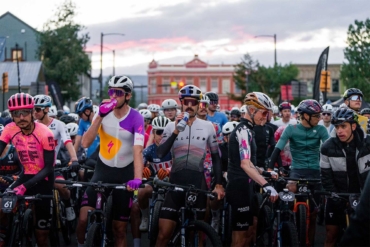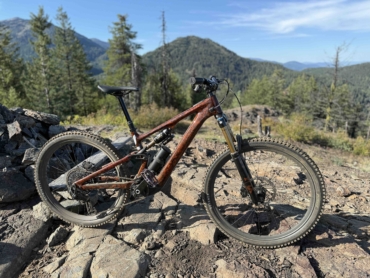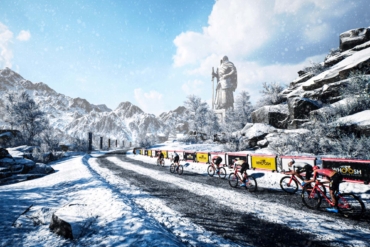Champions Jay Petervary and Josh Kato share with GearJunkie what essential bikepacking gear is in their kit on race day. Here’s everything you need for an epic ride.
Most gear has a defined purpose, and you either need it for your adventure or you don’t. But the bikepacking gear you bring on a race or epic ride is trial and error — you’re your own guinea pig. Because what works for one may not work for another. Weather, conditions, altitude — bikepacking gear is a puzzle with pieces procured and fitted through experience.
We sat down with Josh Kato, winner of the 2015 Tour Divide, and Jay Petervary, who’s podiumed at nearly every major bikepack racing event, to learn what bikepacking gear they bring on a self-supported bikepack race.
10 Bikepacking Gear Essentials
1. Bike
JayP: If you’re into drop handlebars, a gravel bike that has had some development with adventure in mind is way more capable than you may think. If you choose one that can fit 700x50mm (1.9) or 650×2.1mm tires, you can do just about anything with it. Trust me, I’ve taken this type of bike to the line and crossed it.
And some gravel bikes have more useful accessory mounting options for your luggage as well. Personally, I like the gravel bike for its narrower Q-factor, as well as being able to string gravel or road components on it without the hiccups involved with MTBs and/or drop-bar MTBs. A lot of modern gravel bikes are single-day race-worthy and adventure-worthy without compromise.
Kato: You can’t ride an epic without one. While your bike doesn’t necessarily need to be a dedicated “gravel” bike, you’ll be better off with a bike that matches the terrain.
Also, consider gearing. Unless you’re familiar with the course, having a wider range of available gearing is better than being stuck wishing you had more. My bikepacking bikes are all set up with 2x or 3x cranksets. I’ve never done a bikepack race with fewer than two chainrings, and I much prefer my triple. A 3×10 is my current setup. I’m probably in the minority with this, but I really like multiple chainrings.
2. Packs
JayP: I’m a bag dork. I have a lot from many different brands, but I’m also very particular when it comes to racing. That puts me in a space where I get a lot of my bags custom made for my specific need. And really, it’s not just about the bags, as racks are plenty useful and relevant, too.
Kato: I’m all for bags that strap to your bars, seat, or frame. They’re simple, reliable, and weigh much less than panniers and racks.
I almost always use a small hydration pack. They don’t weigh much when empty, but they can be lifesavers when filled with food and extra water for long sections with no resupply options. My favorites right now are Apidura Expedition bags for the bike and a Mammut MTR 201 trail running backpack for my body.
(Note that the MTR 201 is no longer in the Mammut line, but check out the brand’s other trekking and running packs here.)
3. Lights
JayP: This technology changes almost daily, and it’s pretty dang amazing right now. Go get 2 Fenix flashlights and a couple of their 3500mAh batteries, and you will be blown away by the light output and the run times.
I used to use a dynamo hub quite a bit, but less nowadays with the battery technology. I kind of make that decision on the remoteness of the event or route, and four nights is where I start to reconsider using the dynamo.
Kato: If you’re out for more than a day ride, you’ll need lights. The kLite lighting system, powered by a Schmidt hub, has been pretty bombproof on my solo bike and my tandem. I’ve used the Sinewave Revolution charger with success, but I feel that the new kLite charger is superior.
I also carry a Fenix LD22 AA battery-operated light as my backup and auxiliary light. I strap it to my handlebars or helmet with a Twofish mount.
4. Water Purification
JayP: I like to keep it simple and typically will strategize to not have to filter water. And if I do, I just bring some chloride tabs.
Kato: I prefer clean tap water to filtration, but that’s not always possible. So I always carry a Sawyer Mini Filter and some Potable Aqua purification tablets. The Sawyer has been great. You can drink out of mud puddles with it like a straw or fill your bottles with it. The tabs require a wait time but are a great backup item. Not all tabs and filters work against certain organisms, so take heed and match to your needs.
Still, I usually have a high water-carrying capacity, around 10 liters between my frame bag, bike bottles, and backpack. I find carrying a little extra water weight is faster than stopping to refill.
5. Sleeping Kit
JayP: Coming from a race perspective, I had Moab-based Nunatak make me two sets of insulated knickers (one down, one synthetic) and an insulated tube skirt.
Kato: Ah, my puffy suit! For the past few years, I’ve thinned this kit down to a Montbell Ex Light Down Anorak, GooseFeet Gear down pants, and down booties. It’s ultralight, ultrasmall, and very warm. Just don’t get it wet, or you’ll have that wet dog look (and smell).
As for bedding, I’ve been going without a sleeping pad for a few years now. I prefer the bare ground or a bed of pine needles. My wife, Valerie, tried my method during our tandem assault on the Smoke and Fire a few years ago, and she hated it. To this day, she still carries a sleeping pad. So you’ll need to decide between comfort and weight.
6. Shelter
JayP: Depending on the event location and how long it is, I pair the items above with an insulated jacket and an emergency bivy bag. When not racing, I use a full Big Agnes kit — a fat 3-inch-plus pad, a warmer-than-needed bag, and a tent to keep it comfy!
Kato: I usually bring a Montbell Sleeping bag cover. It’s not much of a shelter, but it’s mostly waterproof, light, and small. My favorite shelter is none at all: just a big tree overhead and pine needles below. But I do sometimes use my rain gear over my down jacket and pants if I don’t have a bivy and the weather is wet or snowy.
And I always carry a space blanket. It’s saved me a few times.
7. Clothes
JayP: Minimal. Nothing extra. Every piece of clothing I bring can be worn all at once or in different combos. Nobody said you can’t put your long sleeve on top of your short sleeve, or your puffy jacket can’t go on top of your rain jacket and vice versa. I rarely change clothing, but often just layer.
Kato: My kit is pretty slim: a small beanie hat, a Buff, arm and leg warmers, sun sleeves, shorts, and a jersey. And my sleep kit doubles as my warm clothing kit.
For rain, I use Montbell’s Versalite jacket and rain pants. I pair it with waterproof rain mittens and warm liners.
You really don’t need much to go far, but having windproof and warm clothing from head to toe can save your life.
8. Chamois Butter
JayP: I use sunscreen and that is it.
Kato: I mix my own and apply twice a day. I use equal parts clotrimazole cream and benzoyl peroxide cream. I also mix in some A&D ointment if I get some hot spots.
And don’t forget wet wipes — they are key. Cleanliness!
9. Shoes and Socks
JayP: I size up one size for multiday riding to allow for multiple socks and possible feet swelling. I also carry three pairs of socks — one light, one medium wool, and one expedition wool. I also carry plastic bags (or formal vapor barriers) for water protection.
I’ve been super fortunate to be able to work with Fizik and wear all their shoes for different applications. They’ve also taken my feedback on all my favorite pairs of their shoes and made me custom ones.
Kato: I always use oversized shoes, up to a full size or more too big. It’s important (for me) to allow the feet to swell over the repeated 20-plus-hour days on the bike. Plus, you have room to layer up socks or add water barriers if needed. (You can also wiggle your toes freely to the tunes in your head.)
My favorite socks are Drymax Cold Weather running socks and NRS HydroSkin 0.5 Wetsocks. Warm when wet is key. The combination of dry and warm proves an elusive luxury.
10. Organization
JayP: You’d better be! I pack, unpack, pack another way, unpack, pack another way — and then label most anything I can with a sharpie. I write “left” on it if it is a left. I put duct tape on my bags and write down what’s in it. I do all this on the lead of events, so it’s embedded in my brain where things are and what exactly I am carrying.
I recommend going on a simulation ride that will force you to put your bikepacking gear where you want it in real time (instead of in the garage). Not everything needs a bag. No need to put bags in bags, but do organize and isolate some things.
Kato: Where you pack your gear depends on how wet it will be and how often you’ll need to grab specific items. So, it really depends on the weather.
Generally speaking, my sleep and shelter kit is in the front roll on my handlebar, and my clothing is in the seat bag. Water and tools go in the frame bag, and food sits in top tube bags or a backpack.
I find it more important to make sure that everything is strapped down, closed, and secured than it is to have a specific location for everything. I like to utilize one of the strap-on accessory pockets that goes onto the front roll bag as a go-to. I start with it empty and then use it as needed on the course.
(If you’re a visual learner, you can check out this illustrated bikepacking gear guide.)



















